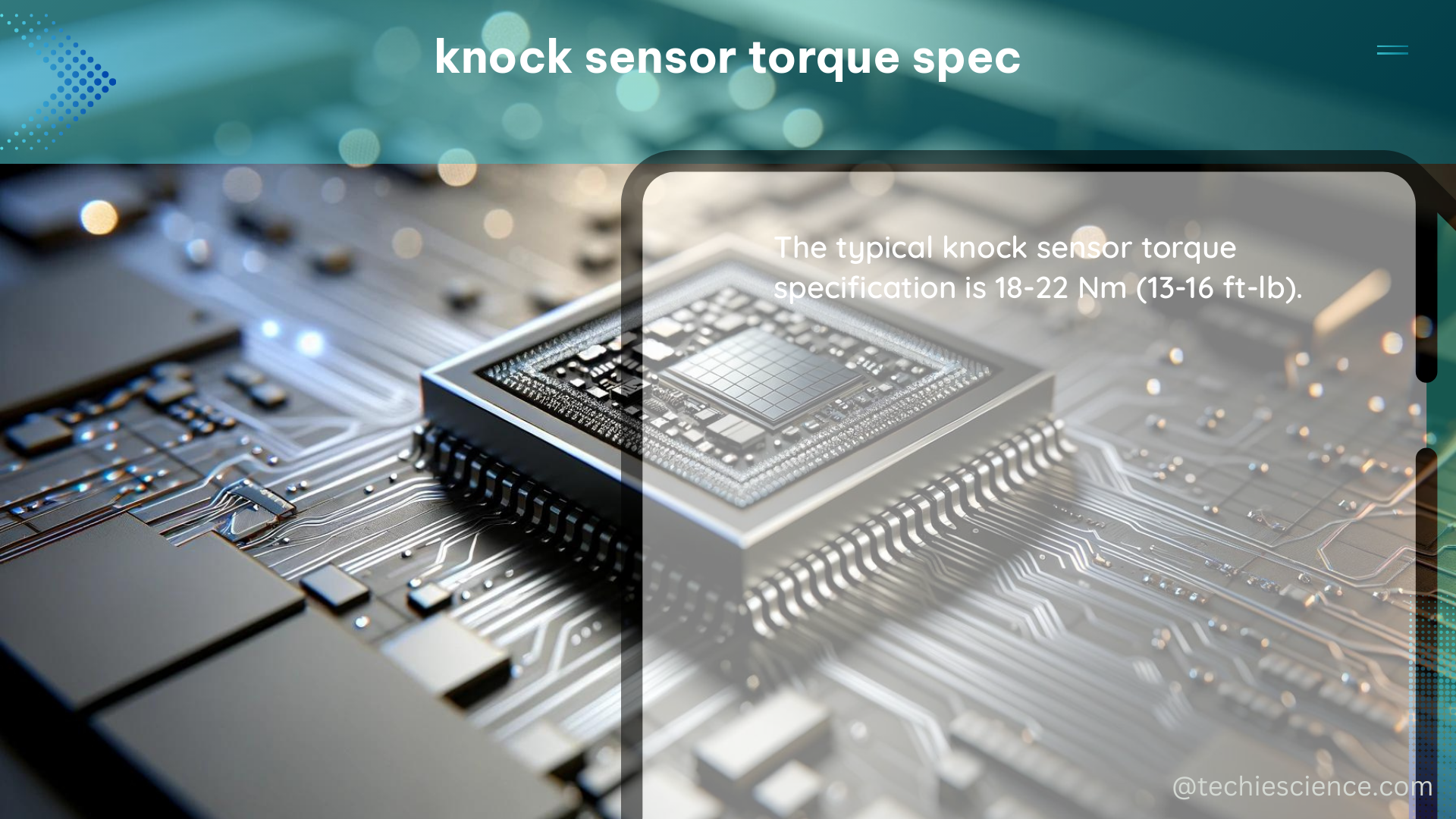The knock sensor torque specification is a critical measurement for ensuring proper installation and preventing damage to the sensor or engine. This comprehensive guide delves into the technical details of knock sensors, their torque requirements, and the best practices for DIY installation or replacement.
Understanding Knock Sensors
Knock sensors, also known as knock detectors, are essential components of an engine management system. They are responsible for detecting engine knocking or detonation, which can cause significant damage to the engine if left unchecked. Knock sensors are typically mounted on the engine block and use a piezoelectric crystal to convert mechanical vibrations into electrical signals.
The primary function of a knock sensor is to provide feedback to the engine control unit (ECU), which can then adjust the ignition timing or fuel delivery to prevent further knocking. This process helps optimize engine performance, improve fuel efficiency, and protect the engine from potential damage.
Knock Sensor Torque Specification

The recommended torque specification for knock sensors varies depending on the make, model, and year of the vehicle. However, the general range for most vehicles is between 8 to 22 Nm (Newton-meters). It is crucial to consult the vehicle-specific repair manual to ensure you are using the correct torque specification for your particular application.
Proper torque application is essential to prevent damage to the knock sensor or the engine. Over-tightening the sensor can cause it to break, while under-tightening can result in poor electrical contact and inaccurate readings. Using a calibrated torque wrench is highly recommended to ensure the sensor is installed correctly.
Torque Specification by Vehicle Make and Model
To provide a more comprehensive understanding, here is a table outlining the knock sensor torque specifications for some popular vehicle makes and models:
| Vehicle Make | Model | Knock Sensor Torque Specification (Nm) |
|---|---|---|
| Toyota | Camry | 12-15 Nm |
| Honda | Civic | 10-12 Nm |
| Ford | F-150 | 14-18 Nm |
| Chevrolet | Silverado | 16-20 Nm |
| Volkswagen | Golf | 8-10 Nm |
| BMW | 3 Series | 12-15 Nm |
| Nissan | Altima | 10-14 Nm |
| Hyundai | Sonata | 12-16 Nm |
It’s important to note that these values are general guidelines, and the specific torque specification for your vehicle may differ. Always refer to the manufacturer’s recommended torque specification in the vehicle repair manual.
Technical Specifications of Knock Sensors
In addition to the torque specification, it’s essential to understand the technical specifications of knock sensors. These include:
- Resistance: The typical resistance range for a knock sensor is between 1,500 to 2,500 ohms.
- Frequency Range: Knock sensors operate within a frequency range of 5 to 15 kHz (kilohertz).
- Temperature Range: The temperature range for knock sensors is typically between -40 to +125°C (-40 to +257°F).
Knowing these technical specifications can help you identify and troubleshoot any issues with the knock sensor during installation or maintenance.
DIY Knock Sensor Installation and Replacement
When approaching a DIY knock sensor installation or replacement, it’s crucial to have the right tools and follow the vehicle-specific repair manual’s instructions carefully. Here are some key steps to consider:
- Tool Preparation: Ensure you have a calibrated torque wrench, socket set, and any other necessary tools for the job.
- Engine Temperature: Make sure the engine is at the correct operating temperature, as specified in the repair manual, before attempting to remove or install the knock sensor.
- Sensor Alignment: Pay close attention to the sensor’s orientation and alignment during installation to ensure proper electrical contact and accurate readings.
- Torque Application: Use the torque wrench to tighten the knock sensor to the manufacturer’s recommended specification, taking care not to over-tighten or under-tighten the sensor.
- Electrical Connections: Verify that the electrical connections to the knock sensor are secure and free from any damage or corrosion.
- Post-Installation Checks: After the installation, perform any necessary diagnostic checks or tests to ensure the knock sensor is functioning correctly.
By following these best practices and the vehicle-specific repair manual, you can successfully install or replace a knock sensor while ensuring the proper torque specification is applied.
Conclusion
The knock sensor torque specification is a critical measurement that must be accurately applied to ensure the proper installation and functioning of this essential engine management component. By understanding the technical details, torque requirements, and best practices for DIY installation, you can confidently maintain and repair your vehicle’s knock sensor system.
Remember, always refer to the manufacturer’s recommended torque specification and follow the vehicle-specific repair manual’s instructions to ensure the safety and longevity of your vehicle’s engine.
Reference:
- Knock Sensor Torque Specifications
- Knock Sensor Installation Guide
- Knock Sensor Technical Specifications

The lambdageeks.com Core SME Team is a group of experienced subject matter experts from diverse scientific and technical fields including Physics, Chemistry, Technology,Electronics & Electrical Engineering, Automotive, Mechanical Engineering. Our team collaborates to create high-quality, well-researched articles on a wide range of science and technology topics for the lambdageeks.com website.
All Our Senior SME are having more than 7 Years of experience in the respective fields . They are either Working Industry Professionals or assocaited With different Universities. Refer Our Authors Page to get to know About our Core SMEs.